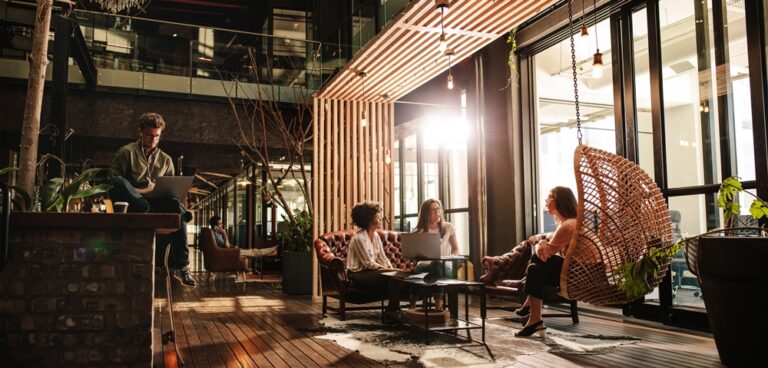Yaron Rosenblum, Co-Founder of Canvas Offices, explores the growing importance of alternative workspaces.

Traditional office layouts are out, now being replaced with tailored alternatives, also known as flexible office spaces, that cater to a variety of workspace options, shared facilities and amenities. These spaces truly support the diverse ways real-world employees work in the modern business world. From quiet zones and collaborative areas to standing desks and wellness rooms, incorporating what were previously considered ‘out-of-the-box’ office alternatives is now becoming the norm. This is no longer a trend but a strategic necessity for any business wanting to positively support its employees. These spaces offer advantages for employees that enhance productivity, wellbeing, and overall job satisfaction.
1. Catering to Diverse Work Needs
Modern work requires flexibility. Employees are often switching between tasks, and on any given day, an individual may need to meet with colleagues, focus deeply on solo tasks, take confidential calls, or even recharge between meetings. Expecting a single desk to serve all those purposes is both inefficient and unrealistic in today’s society.
UK search engine for office spaces, Office Genie, found in recent research, that 58% of employees believe their workplace lacks areas that support quiet, individual work, with 74% desiring ‘chill out’ areas.
Alternative spaces allow employees to choose an environment that best suits their task at hand, improving their task alignment and productivity.
2. Boosting Productivity and Focus
One of the most common challenges in open-plan offices is distraction, with a study published by the Journal of Environmental Psychology finding that exposure to acoustic distractions in open office environments resulted in a 15% decline in cognitive performance on tasks requiring sustained attention and memory recall.
When employees have nowhere to retreat for focused work, output suffers. By offering designated quiet zones or private working areas, companies reduce cognitive overload and improve concentration levels.
According to a survey from recruitment agency, Wifi Talents, 37% of employees believe that having quiet zones in the workplace would increase productivity, indicating a clear preference from employees, to have the option to work in an environment that minimises distraction and encourages productivity.
3. Supporting Employee Wellbeing
Burnout and mental fatigue are real, especially in high-pressure environments. Alternative spaces that prioritise comfort, greenery, natural light, or even relaxation is the new preference for the modern employee, aiding in creating
Wifi Talents reports that 43% of employees say that having access to quiet spaces can reduce stress levels, while 55% of employees surveyed feel having visibility to natural elements such as plants, improves their mood at work.
These environments are no longer considered luxuries, they are essential for building a culture of trust and care within your business. When employees feel supported, they’re not just happier, they’re also more loyal, productive and engaged.
4. Building a Collaborative Workplace
Creativity often sparks in unexpected moments, over coffee or during a chance hallway chat, not exclusively in a meeting room. Alternative collaborative spaces encourage these spontaneous conversations by breaking down the formality of a traditional office space.
In a world where innovation is key to staying competitive and up to date with trends, creating the conditions for natural collaboration could be a game changer.
5. Enhancing Flexibility in Hybrid Models
As hybrid continues to be the standard in the UK, the office is no longer just a place to sit and work, it’s a destination for collaboration, community, and culture. Alternative workspaces allow for a seamless transition between remote and in-office work by catering to the different reasons people come in.
Flexible workspaces are integral to the work from home and office transition, providing flexibility on how and where people work. According to the International Workplace Group, 83% of workers consider a hybrid workplace model as the ideal working environment.
Some might seek quiet focus after a week of home distractions, others might need in-person collaboration. Offices that cater to these diverse needs reinforce the value of coming in and help make the commute worth it.
Why Should Every Office Environment Prioritise Flexible Workspaces?
Considering all of the benefits above, companies should stop referring to adaptive work environment solutions as ‘alternative’ and begin to embrace them as a necessary provision for their teams.
When organisations invest in the right equipment and spaces for their employees, it signals commitment, not only to driving improved performance but to supporting flexible, inclusive, well-being oriented working, with Gen Zers now prioritising wellbeing over pay in many cases. According to professional wellbeing services consultancy,
Barnett Waddingham, one in four of Gen Z employees surveyed had taken a lower-paying job in exchange for better work-life balance, highlighting their preference for jobs that support personal purpose and wellbeing. Creating work environments that are truly dynamic, adaptable, and responsive to team needs is absolutely essential and signals an organisation’s commitment to flexibility, inclusion, well-being, and performance. The future of work, demands environments that are as dynamic and adaptable as the people in them.
Forward-looking companies that invest in such environments aren’t just creating better workplaces, they’re creating better cultures, stronger teams and improved business outcomes.

